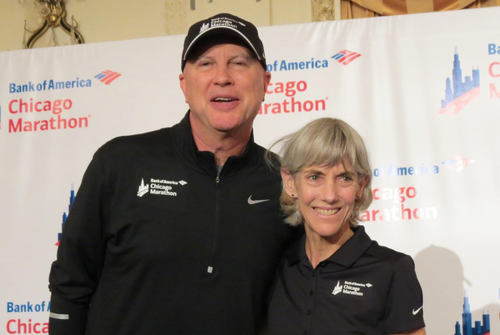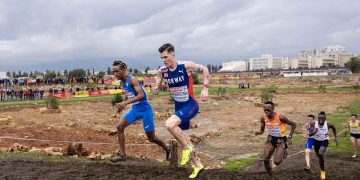 Carey Pinkowski and Joan Benoit Samuelson, photo by David Monti, RRW, used with permission.
Carey Pinkowski and Joan Benoit Samuelson, photo by David Monti, RRW, used with permission.
Way back in 1977, in the predecessor of Outside magazine, Mariah, there existed a wonderfully thoughtful writer named John Jerome. He wrote a piece on Frank Shorter, who, after having won two Olympic medals, a gold and a silver, had brought much focus on the marathon distance in the U.S. Men and women were putting on their running shoes, buying copies of Runners World (went from 50,000 subscribers to 400,0000), and running one of the big city marathons (New York, Chicago, LA then).
In that article on Frank Shorter, the late John Jerome wrote one of the most prophetic lines about a marathoner ever: ” In putting 26 miles together at five minutes per mile, Frank Shorter invented running.” I always thought that Jerome had encapsulated the first running boom in that one sentance. I was, and am, so in awe of that line.
Now, move, dear readers, to the present. Joan Benoit Samuelson has been not only a beacon of running, but a beacon of promoting opportunities for women in sport and championing her sponsor, Nike, and its realization of the opportunities in athletics with women.
Joan Benoit Samuelson is celebrating her 30th anniversary of her epic victory in Chicago over Ingrid Kristiansen, in an American record that lasted 18 years. Joan Samuelson was not about fun running, nor was this about finishing. Joan Samuelson, on the shoulders of runners such as Nina Kusick, Jacqueline Hansen, Christi Vahlensheck and Lorraine Molller, built up the focus around women’s marathoning. Samuelson raced hard, no quarter given, no quarter asked.
Joan Benoit stole the Los Angeles Olympic marathon, and while naysayers commented on TV, Joan won the first Olympic title. Her battle in 1985 against Kristiensen was a gut wrenching battle where two fine athletes red lined the pace for 21 plus miles before the Mainer stubborness of Joan Benoit Samuelson overcame the stoic Norgwegian Kristiansen.
Watching Joan now, I still see that stubbornness. I wonder how Scott, her husband, and a keen observer of this sport, has been able to help her focus her drive and energy.
Here is the piece by David Monti, written on Thursday for Race Results Weekly. We use this piece with permission.
SAMUELSON CELEBRATES 30TH ANNIVERSARY OF RECORD RUN IN CHICAGO
By David Monti
(c) 2015 Race Results Weekly, all rights reserved, used with permission.CHICAGO (08-Oct) — Wearing her red and white Athletics West kit, 28 year-old Joan Benoit stepped to the starting line of the Chicago Marathon 30 years ago here this month as the first-ever women’s Olympic Marathon champion. She was simply known as “Joanie,” the plain-spoken New Englander from Cape Elizabeth, Me., whose one-minute and 26-second Olympic victory in Los Angeles the year before captured the imagination of American sports fans and helped launch a still-growing boom in distance running for women.
But in that race here in 1985 she perhaps not the favorite for victory. Six months earlier, Norway’s Ingrid Kristiansen had shattered the world marathon record, running 2:21:06 at the London Marathon, the first-ever sub-2:22 marathon by a woman. Kristiansen was on the starting line with Benoit (now Samuelson) as was Portugal’s Rosa Mota, the 1984 Olympic bronze medalist who would go on to win the Olympic title in 1988.
“It really has been one of my most favorite memories in the sport,” said Samuelson speaking to a small group of reporters here today. She continued: “Rosa was the third place finisher in the L.A. Olympics, the inaugural women’s Olympics. And then she want on to win the gold in Seoul. Ingrid at the time had the world’s best time, so it was a big-time field.”
Steve Jones went out hard in the men’s race, dusting the field by nearly a minute to win in 2:07:13, just one second off of Carlos Lopes’s world record. But the women ran hard, too. Kristiansen and Samuelson –and a few brave amateur men– went out at a sub-2:20 pace. Mota chose to hang back.
“I just remember running head-to-head with Ingrid,” said Samuelson, who now wears her silver hair shoulder-length. “It was a gray day, and I was just hoping she would break at 10 (miles). I said I will try to hold on to her until 13, and she started to fall of the pace a little bit at 10.”
Samuelson took over the lead, but Kristiansen stayed close. She went through the 17 mile (27 km) point on a 2:20:12 pace, which was too hot for Kristiansen.
“I just said, oh my God, you’ve just got to stay strong and go for it,” Samuelson recounted.
Samuelson left Kristiansen, pulling away to run a solo 2:21:21, shattering her own American record of 2:26:12, and even surpassing her American “best” of 2:22:43 set at the 1983 Boston Marathon (that course isn’t eligible for record-setting). Her mark stand up for over 17 years until Deena Kastor broke it in the 2003 London Marathon when she ran 2:21:16.
“To be able to hold on in that race and come up on top was almost as special as the Olympic win,” said Samuelson, who admitted that she had made an error in her preparations and perhaps could have run faster.
“I do have one regret,” she said. “And that was I didn’t look at the race course before I ran. I never look at marathon race courses before I run the actual race, because what I don’t know can’t hurt me. Had I known where the finish line was, because all of a sudden, there was the finish line, and I still had something in the tank.”
On Sunday here, Samuelson hopes to run the race, but a health problem will prevent he from trying to run her goal of running 2:51:21, an extraordinary mark for a 58 year-old.
“I’ve been dealing with a stomach virus, so it will be a game-time decision,” Samuelson said. “My original thought was to run within 30 minutes of my original time 30 years ago, and I was on target to do so. As all marathoners walk or run a fine line, I was on that fine line three weeks ago, and started to fall apart a little bit. We’ll see if I’m well enough to cover the distance. That’s not my style, but it’s the 30th anniversary and it’s a big deal for me. I’ve worked hard.”
Author

Larry Eder has had a 52-year involvement in the sport of athletics. Larry has experienced the sport as an athlete, coach, magazine publisher, and now, journalist and blogger. His first article, on Don Bowden, America's first sub-4 minute miler, was published in RW in 1983. Larry has published several magazines on athletics, from American Athletics to the U.S. version of Spikes magazine. He currently manages the content and marketing development of the RunningNetwork, The Shoe Addicts, and RunBlogRun. Of RunBlogRun, his daily pilgrimage with the sport, Larry says: "I have to admit, I love traveling to far away meets, writing about the sport I love, and the athletes I respect, for my readers at runblogrun.com, the most of anything I have ever done, except, maybe running itself." Also does some updates for BBC Sports at key events, which he truly enjoys. Theme song: Greg Allman, " I'm no Angel."
View all posts




















